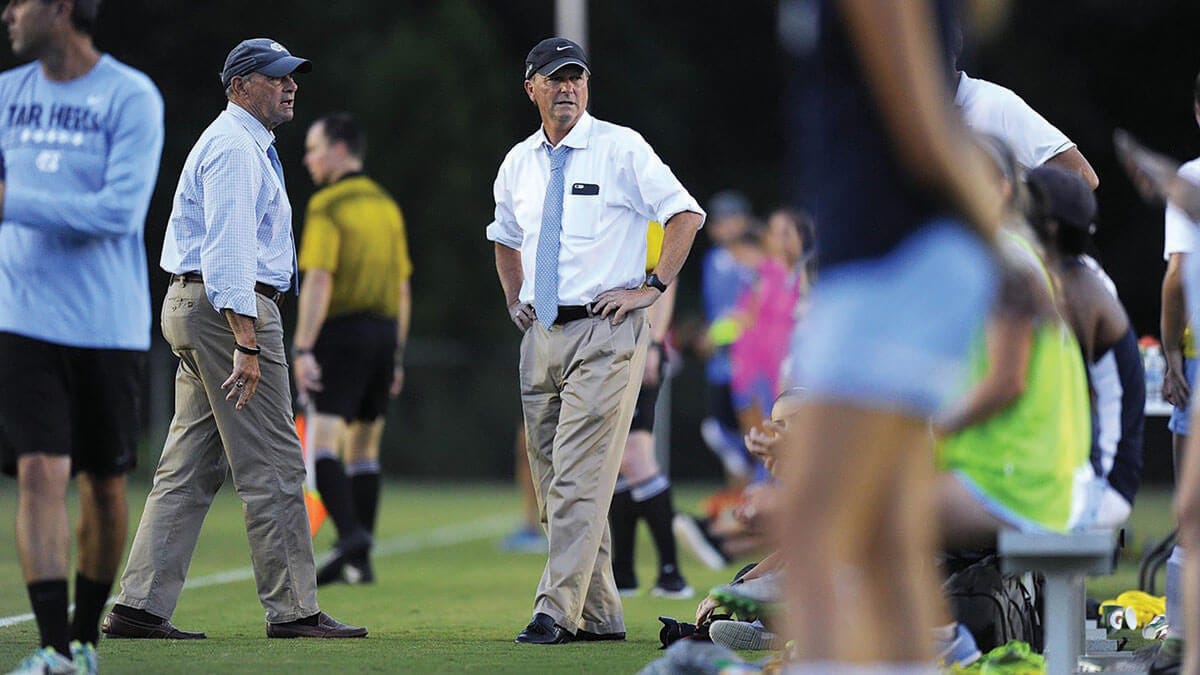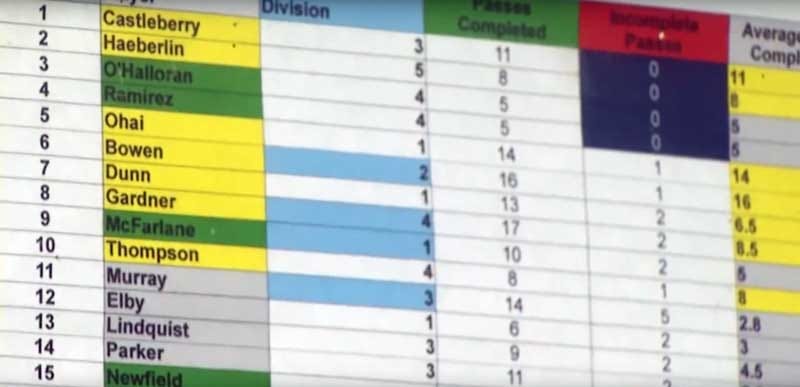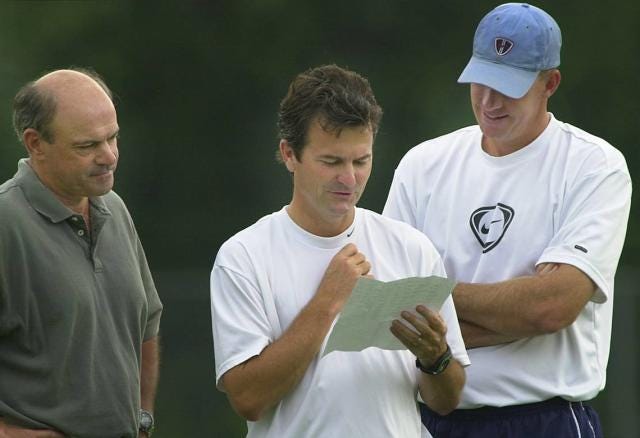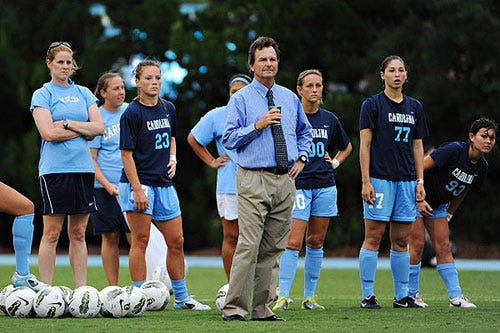The Best You've Never Heard of Pt. III
Data, Core Values & Mastering the Intangibles Turned a Nonexistent Program into a 21X National Champion.
Anson Dorrance. Unless you bleed Tar Heel Blue or follow Women’s Soccer, you have likely never heard the name. When most hear “Tar Heel Blue” Michael Jordan is the first name that comes to mind. Second might be legendary basketball coach Dean Smith. But it was Coach Smith who once said that the University of North Carolina, “is a women’s soccer school. We’re just trying to keep up with them." Dorrance built the women’s program from scratch. Today, his influence permeates across all of the top programs as many national championship-caliber teams are led by coaches who either played for or coached with Dorrance.
Resume:
45 seasons as Head Coach of UNC Tar Heels Women’s Soccer.
21 national championships.
1,106-152-74 Total Win-Loss-Tie Record.
Record of 934-88-53 as Women’s Coach (1977 - 2023).
Record of 172-64-21 as Men’s Coach (1977 - 1988).
31 College Cup (Final Four) Appearances.
103-game unbeaten streak from 1986-1990 (97-0-6).
101-game unbeaten streak from 1990-1994 (99-0-2).
UNC Tar Heels are the only Women’s Soccer program to appear in every single NCAA tournament.
He has coached 19 different players to National Player of the Year honors.
7X National Coach of the Year.
Prior to stepping foot onto campus in Chapel Hill as an undergraduate, Anson Dorrance had already lived a fascinating life. Born in Bombay, India as the son of an oil executive, Dorrance moved from Ethiopia to Kenya to finishing out at a Swiss boarding school. These experiences profoundly shaped him as a young man. For a more detailed background on his early years, please pick up a copy of his biography The Man Watching (Crothers, T., 2006). It was at University of North Carolina’s Teague Dormitory where Dorrance’s ferocious ambitious nature put his competitors on notice.
“The vision of a champion is someone who is bent over, drenched in sweat at the point of exhaustion when nobody else is watching.”
Anson Dorrance
Dorrance participated in every possible intramural sport that he could. Dorrance informed the organizer of intramural sports for Teague Dorm that if they wanted to win, they need to put Dorrance on every single team. At the time, there were no league standings in UNC’s intramural sports, nor was there any scorekeeping. Since his opponents embraced this philosophy, it was the perfect environment for Dorrance. He went out and recruited athletes from the local public basketball courts. “I believed in beating everybody to death by the maximum score in every game possible,” said Dorrance at his recent retirement ceremony. They recruited incoming freshmen with athletic backgrounds and trained together. They beat everybody to death at every opportunity they had. Dorrance shared this with the opposing teams, “If winning doesn’t matter to you, fine. But we’ve discovered our morale is a lot better when we win.” His fellow competitors hated him. In true Dorrance fashion, he welcomed it with open arms. This was the start of a 17-year Teague Dorm Intramural dynasty.
Dorrance’s love for soccer led him away from intramural sports and onto UNC’s men’s soccer team. His ruthless competitive disposition earned him the the role of Captain of the soccer team. He was a three-time All-ACC player and graduated with a B.A. in Philosophy and English.
Dorrance was confident (some say arrogant), brash and lightning quick with words. These qualities tremendously helped him while, at times, also got him in trouble. A classic Dorrance story from his time on the soccer team at UNC occurred in the on-campus cafeteria that was excluded to the school’s student-athletes. An all-conference linebacker cut the food line and Dorrance wasn’t having any of it.
Dorrance saw him and called him out, “Who the hell are you? Get to the back of the line”.
The linebacker replied, “Who the hell are you? What sport do you play?”
“I’m Anson Dorrance and it doesn’t matter what fucking sport I play. Get behind me”, replied Dorrance before a near melee broke out in the cafeteria.
Dorrance went on to law school to fulfill the dream of his father, Pete. But Dorrance bled Tar Heel Blue. Marvin Allen, his former coach at the University of North Carolina, called. Allen was hanging it up. The head coaching position was open for the Men’s team with the opportunity to start a Women’s team. Dorrance accepted the position, exchanging a lucrative career in law for one that granted him a budget of $4,655 (beyond his paltry salary) to coach.
In his first season as the Women’s coach, the Tar Heels were just one of five universities East of the Mississippi River that had Women’s Soccer teams. His first match was against UNC Wilmington’s Women’s club soccer team. His concern was focused less on winning than it was finding competition. During his first eight seasons as the Women’s Head Coach, Dorrance simultaneously sat at the helm of the Men’s program (something that would be unheard of in today’s overspecialized world). By 1982, Women’s soccer programs had proliferated across the U.S. so much that an official playoff and national championship was held. Dorrance’s Tar Heels pounced at the opportunity and won the inaugural Women’s NCAA Championship. Little did he know, or the soccer landscape, of what was to come.
For the next two decades, his Lady Tar Heels pulverized their competition. During an unprecedented run from 1986 - 1993, Dorrance’s squads won 181 matches and lost only once. Yes, you read that right: one loss in 7 seasons. During the 80s and 90s, the Tar Heels won 12 National Championships in 13 seasons.
According to his longtime assistant coach, Bill Palladino, “A lot of coaches are as competitive as Anson, but nobody is as verbally combative as him.” Interview him and you will get candid, often unpolished responses. In his early years of coaching, he was notorious for sharing cliches on the differences between coaching men and women. “Women are more sensitive and demanding of each other and that combination is just horrible.” Dorrance loved conflict. He sought it out and imprinted that mentality upon his athletes. Other teams marveled at the Lady Tar Heels. Not only were the head and shoulders more talented than their peers, but they were the hungriest. They
Outside of soccer, Dorrance was and is known for being scatterbrained. His work desk was covered by a mound of papers. He once found a $500 check addressed to him years after it was written. It was not a rare occurrence for the UNC Women’s teams to sprint through airports with the hope of avoiding missing a flight. To him, these things were utterly important.
What mattered to Dorrance was mastery. Nothing would interfere with that journey. Not even the formality of being referred to as coach. Dorrance rejected the “Coach” title and, instead, insisted that his players call him Anson because could not stand the idea of a hierarchy. He devoured every genre of literature as a means to help him better understand his athletes as people so that he could assist them on a lifelong ascension. While at the University of North Carolina, mastery was the objective. He never once uttered the word “winning” because he was hellbent on preparation and knew that Carolina Way would take care of the results.
“It’s my job to bring them to their potential and that’s not entirely comfortable for them. The Competitive Cauldron is like competing on the surface of the sun.” Anson Dorrance
On this topic of living life as a never-ending ascension, Dorrance was extremely detailed in organizing his practices. In fact, he was so thorough that he planned them down to the minute. He learned this organizational technique after receiving an invitation from legendary coach Dean Smith, two-time National Champion, to attend a University of North Carolina Men’s basketball practice. Smith’s practices were closed-off to the public and tarps covered the doors so that nobody from the outside world could catch a glimpse. "It's almost like you've been brought in to watch the Pope give Mass and you're invited to sit in the front pew," Dorrance said after attending.
While observing, Dorrance noticed how well-planned the practice was: 5:00 dribbling, 5:03 stretching 5:07 lay-up drill… To take it one step further, Coach Smith would post the practice plan ahead of practice. Everything was done with precision. No wasted time. The assistant coaches were equally as involved, tallying every layup, three-pointer, free-throw, turnover, rebound or whatever statistic they could create. The goal with this level of detail is that it provided the coaches more data to make more well-informed decision while, simultaneously, it cultivated a fiercely competitive and focused practice environment. This was the impetus for Dorrance to take Smith’s method and “soccerize” it thus spawning the renowned “Competitive Cauldron”.
The Competitive Cauldron has become a part of soccer lore since Dorrance first created his version of it in the 1980s. Many of the elite Division I programs have since implemented their own versions of it. The Cauldron took Dorrance’s soccer program from NCAA Champion to NCAA Powerhouse. Dorrance involved his assistant coaches and graduate assistants in keeping track of the statistics and entering them to a spreadsheet after each practice. He created 28 different categories. They have been the same since the Cauldron was first developed. Some the statistics they kept track of: passes completed, penalty kicks, sprinting tests, hardest shot, agility tests, strength tests scored, At the end of each week, Dorrance posted his Competitive Cauldron scores ranking each player from first to last. The goal drove competitiveness to a high-level and provided the players direct feedback regarding which parts of their game needed improvement. It was purely objective and, thus, all about accountability. Nobody, not even a Mia Hamm, could hide from the data.
Dorrance believed this to be crucial in developing mental conditioning. Did it ever drive competitiveness? Many of his players from years’ past have gone on record stating that Dorrance’s practices were far more intense than the actual games. In fact, they said, that the games felt like a break. There was no limit to how well any of his athletes could score in the Cauldron’s system, further underscoring Dorrance’s philosophy of embracing life as a never-ending ascension.
Dorrance used the Competitive Cauldron’s ranking system as a reference point for every team that he coached. In a matter of seconds, he could compare a player’s ranking in 2015 to a players ranking in 1992. It should come as no surprise that athletes who made upper of the Competitive Cauldron include World Cup Champions Mia Hamm, Tobin Heath, Crystal Dunn, Heather O’Reilly and Megan Klingenberg. To further underscore just how effective Dorrance’s Competitive Cauldron is, consider the following: a total of 59 former Tar Heels players went on to play for the United States Women’s National Team while 102 of his former players were All-Americans.
Anson Dorrance abruptly retired just this past August before what would have been his 46th season of leading the Lady Tar Heels. “I don’t have the energy to give 100% to this year’s team,” he stated at his retirement press conference. Prior to this retirement conference, Dorrance admitted he had taken his first vacation that extended beyond one week for the first time in his life. For decades, he loathed the idea of a vacation because he felt the competition would get ahead of him. But the gelato in Italy tasted too good and Dorrance interpreted that as a sign. He mentioned how tired he got of responding to emails as well. Dorrance will still be heavily involved with the Lady Tar Heels program that he built from the ground up. Below are some lessons I’ve accrued from having read books, listened to podcasts and streamed interviews on all-things Dorrance.
READ. READ. READ.
Having studied the world’s best coaches across a wide-range of sports (for my own personal edification and in graduate school), reading is one common dominator. Dorrance was always and still is a voracious reader, keeping a rotation of 3-4 books by his nightstand each night. Given his academic background (Majoring English and Philosophy), his interests are wide-ranging. He was able to infuse those lessons spanning across different genres into his coaching practice. Quotes pulled from the books he had read laid the foundation for the “Core Values” that Dorrance’s coaching philosophy was built upon. He didn’t just read coaching or leadership books either. From Stephen Pinker’s Enlightenment Now to David Foster Wallace’s 2005 Kenyon College Commencement Speech This is Water to Victor Frankl’s Man’s Search for Meaning, Dorrance understood that this knowledge would allow him to better to connect with his student-athletes as people and, ultimately, assist them along their own personal paths towards mastery.
MASTERY, ACCOUNTABILITY & CORE VALUES ABOVE RESULTS.
“My challenge would be to never surrender my standards to be more popular with my team, but to push my players to transcend ordinary effort in every training session and match.” Anson Dorrance
Anson Dorrance’s Competitive Cauldron fostered a competitive environment that no other program could match. He never mentioned winning and never tolerated whining. “We Don’t Whine” is actually Core Value #1 on his list of Core Values that he would share with his team each season. Here is a quick summary: “We don’t whine; the truly extraordinary do something every day'; we want these four years of college to be rich, valuable and deep; we work hard; we don’t freak out over ridiculous issues or live in fragile states of emotional catharsis or create crises where none should exist; we choose to be positive; we treat everyone with respect; we care about each other as teammates and as human beings; when we don’t play as much as we would like we are noble and still support the team and its mission; we play for each other; we are well led; we want our lives to be never ending ascensions but for that to happen properly our fundamental attitude about life and our appreciation for it is critical…”. Moreover, Dorrance would have every single member of the team rank every other member of the team on how well they exemplified the Core Values using a scale of 0.0 - 4.0, much like a GPA. Dorrance interpreted that a rating below a 3.0 meant that the student-athlete was a terrible fit or did not want to be a part of their culture. Dorrance expected every single student-athlete on his team to memorize these Core Values and the quotes attached to them.
AUTHENTICITY AND CARE
“My respect for you as a human being has nothing to do with you as a soccer player.” Anson Dorrance
Anson Dorrance has a number of idiosyncrasies, many of which annoyed his competition but were embraced by his team. As a young adult, Dorrance converted from Catholicism to the Church of Latter Day Saints. This meant he was to give up drinking alcohol, caffeine and swearing. He said he could go 2/3 but would never be able to give up swearing. He wore a tie to every single game because Marvin Allen, his former coach and mentor, did. He had a sign on his desk that read, “Illegitimus Non Carborundum” which loosely translates to “don’t let the bastards grind you down”. He refused to be called “Coach” because he rejected the notion of a hierarchy. Some Classic Dorrance-isms include:
On no rhythm: “Touch of a billygoat.”
On clumsiness: “Left foot, right foot, left foot, right foot, left foot, right foot”…
On soft play: “This is not fucking badminton. It’s a contact sport.”
One halftime speech that became their season’s slogan (F.T.S.): “They’re coming after you! Well, tough! Fuck that shit! Let’s go after them!”
The only rules he had for his players were that they show up on time and dress better than him: “Do rules in life really construct you? We create all of these rules and they only entrap players. We want to create a culture of correct behavior and the players can monitor themselves. I trust them.” Three times per year, Dorrance would meet one-on-one with every member of his team. It was part-goal setting part-planning for the future. This was not limited to soccer as “What are your dreams?” was a question he would ask almost every player.
“In athletics, you want to win forever. You want constant renewal. Flowers remind you of the ephemeral quality of success. You must remember what it took to get you there. Flowers die shortly and it’s the same in athletics. You must recommit yourself.” Anson Dorrance on his Pre-Game Championship Tradition.
Dorrance started his seniors in every single NCAA Tournament game and that included walk-ons. He chose honor over talent and used that as a way pay tribute to their contributions. Additionally, in the final moments before every single championship match, Dorrance used that time to share how much he valued each senior. He would read a hand-written letter addressed to each senior on his team and hand it to them with a rose. Dorrance does not treat this as a trivial matter either: “I spend the entire day and half the night prior to the championship game writing these letters to each senior.” He preferred flowers to rings because they wither away and die in a few days which, according to Dorrance, makes this moment all the more meaningful. During these moments, it has been said that there is not a dry eye in the locker room. Powerful indeed.
UNWAVERING CONFIDENCE.
“I’m not always confident, but you will never see me when I’m not.” Anson Dorrance
Dorrance doesn’t believe so much in adversity as in dismissing it entirely. He loved adversity and understood that a lack of it stunted their growth. Dorrance once stated that he wants to be defeated decisively by constantly greater aspirations. He never lost his cool because he knew the impact that would have on his players. So, he made it a point to never let them see his stress. His whole objective was to maximize stress in practice and minimize it during games. Every aspect of Carolina’s program was built upon being able to maintain composure and confidence in a fiercely competitive environment. He was a master motivator and I look forward to learning more about Anson Dorrance’s legendary career and the impact he on sport in the coming years.
Sources:
Crothers, T. (2010). “The Man Watching: A Biography of Anson Dorrance, the Unlikely Architect of the Greatest College Sports Dynasty Ever.” St. Martin’s Press. New York.











